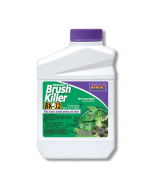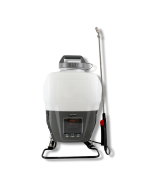Gain access to personalized product screening, the best pricing, rewards, and more!



application2
Bonide Brush Killer BK-32
11/04/25
Bonide Brush Killer BK-32, manufactured by Bonide, is a efficient liquid herbicide that quickly eliminates a broad spectrum of broadleaf weed, brush, and woody weed species within residential lawns.
This water-soluble liquid formulation works systemically, making its way from the weeds tissue down to the roots, causing a complete removal and root kill.
Convenient and easy to mix, Bonide Brush Killer BK-32 can be used as a foliar spray to the leaves and stems of targeted weed species, including cut stumps.
Tools Needed
To use Bonide Brush Killer BK-32, you will need a handheld pump sprayer or hose-end sprayer. We recommend using a handheld pump sprayer for spot applications as it easier to control applications.
How to Use
- Step 1: Stop mowing 1 to 2 days before or after application of Bonide Brush Killer BK-32. Determine how much Bonide Brush Killer BK-32 to use by calculating the square footage of the treatment area. To do this, measure the length and width in feet and follow the formula (length X width = square footage). For acreage, take the square footage and divide it by one acre (square footage / 43,560 = acreage). The rate of application for ornamental lawns and turf will use 3.2 oz. of Bonide Brush Killer BK-32 per 2.5 gallons of water per 1,000 sq. ft. Refer to the label as foliage and weeds will have different application rates. Do not apply more than 2 broadcast applications per year with a minimum retreatment interval of 21 days. Do not apply more than 1.5 lb. of product per acre per year.
- Step 2: To mix in tank type sprayers, fill halfway with the required amount of water, then add the measured amount of Bonide Brush Killer BK-32, and pour in the remaining half of water. Close the sprayer lid and agitate until evenly mixed. For hose-end sprayers, pour in the appropriate amount of product before attaching the container to the hose. Once attached, spray the measured amount of water to mix the solution.
- Step 3: If the soil is dry in your lawn, lightly water before application. Adjust the sprayer nozzle to a fan-spray setting and coat the stem, trunk, top and bottom of leaves until evenly coated, but not to the point of run-off. If weeds are growing up poles, fences, or tree trunks with mature bark, spray to a height of 3 to 4 feet. Wait an hour after application before watering your treated foliage.
Where to Use
Use Bonide Brush Killer BK-32 around your home, cabin, other buildings along fences, weeds growing on poles, fences, tree trunks with mature bark, and established residential turf containing Bluegrass, Fescues, Rye, Bent (except on golf course greens and tees), Bermuda, Bahia, and Zoysia lawns.
Do not use on St. Augustinegrass, centipede lawns, carpet grass, Dichondra, desirable clovers, newly seeded grasses, on or around desired plant and grasses.
When to Use
Spray Bonide Brush Killer BK-32 when weeds are actively growing. Apply on days when the weather is calm, beneath 90 degrees Fahrenheit, and no rainfall within 24 hours is forecasted to avoid drift or wash-off of product.
Safety Information
Bonide Brush Killer BK-32 is safe to use around children or pets when applied according to the product label instructions. Wear the appropriate personal protective equipment (PPE) such as gloves, mask, long-sleeve shirt, long-sleeve pants, and so on to protect your skin, eyes, face, mouth, hands, and feet from poison ivy or poison oak effects.
People and pets will need to wait until spray mixture has dried on treated areas before reentering.
Special Considerations
Bonide Brush Killer BK-32 has the potential to harm or eliminate desired foliage if contacted by the spray mixture. Avoid all contact with foliage and non-mature tree trunk bark. Tree bark is mature if you scratch the bark with your finger and do not find any green tissue.
To treat weeds growing on desired shrubs or green barked trees, cut weeds at base and treat as directed for stumps.
| Availability | Online |
| Restricted Use | No |
| Shipping Restrictions * = not registered** = restricted use | 1 Gallon: AK*, AR**, CA**, HI*, IN**, LA**, SD*, TX**, VT**, WA** 16 Ounce: AK*, HI*, IN**, SD*, VT** 32 Ounce: AK*, HI*, IN**, SD*, VT** |
| Brand | BONIDE |
| Keith's Pro Tips | "If weeds are growing around desired plants, shield them from drift during application with a sheet of cardboard or plastic. If desired plants are accidently sprayed with product, rinse off immediately with water." |
| Product Drawbacks | Bonide Brush Killer BK-32 may cause temporary yellowing of some Bermudagrass turf. |
| Target Pests | Alder, Annual yellow sweet clover, Artichoke, Aster, Austarian fieldcress, Bedstraw, Beggartick, Biden, Bindweed, Bird vetch, Bitterweed, Bitter wintercress, Black-eyed Susan, Black medic, Blackmustard, Black-seed plantain, Blessed thistle, Blue lettuce, Blue vervain, Box elder, Bracted plantain, Brassbuttons, Bristly oxtongue, Broadleaf dock, Broadleaf plantain, Broomweed, Buckthorn, Buckthorn plantain, Bulbous buttercup, Bull nettle, Bull thistle, Burdock, Burning nettle, Bur ragweed, Burweed, Buttercup, Canada thistle, Carolina geranium, Carpetweed, Catchweed bedstraw, Catsear, Catnip, Chickweed, Chicory, Cinquefoil, Clover, Cockle, Cocklebur, Coffeebean, Coffeeweed, Common chickweed, Common mullein, Common sowthistle, Corn chamomile, Creeping jenny, Crimson clover, Croton, Cudweed, Curly dock, Curly indigo, Dandelion, Dead nettle, Dock, Dogbane, Dogfennel, Elderberry, English daisy, Fall dandelion, False dandelion, False flax, False sunflower, Fiddleneck, Field bindweed, Field pansy, Flea bane (daisy), Flixweed, Florida betony, Florida pusley, Frenchweed, Galinsoga, Garlic mustard, Goathead, Goatsbeard, Goldenrod, Ground Ivy, Gumweed, Hairy bittercress, Hairy fleabane, Hawkweed, Healall, Heartleaf drymary, Hedge bindweed, Hedge mustard, Hemp, Henbit, Hoary cress, Hoary plantain, Hoary vervain, Honeysuckle, Hop clover, Horsenettle, Horsetail, Indiana mallow, Ironweed, Jewelweed, Jimsonweed, Kochia, Knawel, Knotweed, Lambsquarters, Lespedeza Locoweed, Lupine, Mallow, Marshelder, Matchweed, Mexicanweed, Milk vetch, Milkweed bloodflower, Mugwort, Morningglory, Mousear chickweed, Musk thistle, Mustard, Narrowleaf plantain, Narrowleaf vetch, Nettle, Orange hawkweed, Oxalis, Oxeye daisy, Parsley-piert, Parsnip, Pearlwort, Pennycress, Pennywort, Peppercress, Pepperweed, Pigweed, Pineywoods bedstraw, Plains coreopsis, Plantain, Poison hemlock, Poison ivy, Poison oak, Pokeweed, Poorjoe, Povertyweed, Prickly lettuce, Prickly sida, Primrose, Prostrate knotweed, Prostrate pigweed, Prostrate spurge, Prostrate vervain, Puncture vine, Purslane, Ragweed, Red clover, Redroot pigweed, Red sorrel, Redstem filaree, Rough cinquefoil, Rough fleabane, Roundleaf marigold, Rush, Russian pigweed, Russian thistle, St. Johnswort, Scarlet pimpernel, Scotch thistle, Sheep sorrel, Shepherdspurse, Slender plantain, Smallflower galinsoga, Smartweed, Smooth dock, Smooth pigweed, Sneezeweed, Southern wild rose, Sowthistle, Spanishnettle, Spatterdock, Speedwell, Spiny Amaranth, Spiny Cocklebur, Spotted catsear, Spotted knapweed, Spotted spurge, Spurge, Spurweed, Stinging nettle, Stinkweed, Stitchwort, Strawberry clover, Sumac, Sunflower, Sweet clover, Tall nettle, Tall vervain, Tansy mustard, Tansy ragwort, Tanweed, Tarweed, Thistle, Tick trefoil, Toadflax, Trailing Crownvetch, Tumble mustard, Tumble pigweed, Tumbleweed, Velvet leaf, Venice mallow, Veronica, Vervain, Vetch, Virginia buttonweed, Virginia creeper, Virginia pepperweed, Wavyleaf bullthistle, Western clematis, Western salsify, White clover, White mustard, Wild mustard, Wild aster, Wild buckwheat, Wild carrot, Wild four-o-clock, Wild garlic, Wild geranium, Wild lettuce, Wild marigold, Wild onion, Wild parsnip, Wild radish, Wild rape, Wild strawberry, Wild sweet potato, Wild vetch, Willow, Witchweed, Woodsorrel, Woolly croton, Woolly morningglory, Woolly plantain, Wormseed, Yarrow, Yellow rocket, Yellowflower pepperweed, and other broadleaf weeds. |
| Application Equipment | Gloves, Hose End Sprayer, Pump Sprayer |
| Application Methods | Broadcast Spray, Spot Treatment |
| Active Ingredient | Dimethylamine salt 13.72%, Triethylamine salt Trichloro 1.56%, and Dimethylamine salt of Dicamba 1.35% |
| Product Type | Herbicide |
| Formulation | Emulsifiable Concentrate (EC) |
| Application Rate | The rate of application for ornamental lawns and turf will use 3.2 oz. of Bonide Brush Killer BK-32 per 2.5 gallons of water per 1,000 sq. ft. Northern lawns containing fescues, Kentucky bluegrass, perennial rye, and zoysia use 4 oz. of product per 1 gallon of water per 1,000 sq. ft. Southern lawns containing Bermuda, bahia, and bent use 2 oz. of product per gallon of water per 1,000 sq. ft. For brush control, apply 4 oz. of product per gallon of water per 1,000 sq. ft. For vines, spray enough product to thoroughly coat the weeds up to a height of 3 or 4 feet. For stumps, apply undiluted product with a paintbrush to the entire cut trunk, cut surface, and remaining trunk and exposed roots. |
| Shelf Life | Bonide Brush Killer BK-32 can remain effective for up to 3 years when stored in a cool, dry environment. |
| Yield | A pint of Bonide Brush Killer BK-32 can create 8 gallons of spray solution. |
| Use Sites | Outdoors |
| Time to Kill | Visual results from Bonide Brush Killer BK-32 can be seen within 3 weeks after application. |
| Comparable Products | Monterey Spurge Power |
| Use Caution With | St Augustine |
| Incompatible Home Siding | Brick, Hardie Plank, Stone Veneer, Stucco, Wood, Vinyl |
| EPA Registration # | 228-334-4 |
| Restricted Use | No |
|---|---|
| Shipping Restrictions | AK, HI, SD |
| Availability | Online |
| Keith's Pro Tip | "If weeds are growing around desired plants, shield them from drift during application with a sheet of cardboard or plastic. If desired plants are accidently sprayed with product, rinse off immediately with water." |
| Time to Kill | Visual results from Bonide Brush Killer BK-32 can be seen within 3 weeks after application. |
| Chemical Type | Herbicide |
| Formulation | Emulsifiable Concentrate (EC) |
| Application Methods | Broadcast Spray, Spot Treatment |
| Product Drawbacks | Bonide Brush Killer BK-32 may cause temporary yellowing of some Bermudagrass turf. |
| Active Ingredient | Dimethylamine salt 13.72%, Triethylamine salt Trichloro 1.56%, and Dimethylamine salt of Dicamba 1.35% |
| Application Equipment | Gloves, Hose End Sprayer, Pump Sprayer |
| Mix Rate | The rate of application for ornamental lawns and turf will use 3.2 oz. of Bonide Brush Killer BK-32 per 2.5 gallons of water per 1,000 sq. ft. Northern lawns containing fescues, Kentucky bluegrass, perennial rye, and zoysia use 4 oz. of product per 1 gallon of water per 1,000 sq. ft. Southern lawns containing Bermuda, bahia, and bent use 2 oz. of product per gallon of water per 1,000 sq. ft. For brush control, apply 4 oz. of product per gallon of water per 1,000 sq. ft. For vines, spray enough product to thoroughly coat the weeds up to a height of 3 or 4 feet. For stumps, apply undiluted product with a paintbrush to the entire cut trunk, cut surface, and remaining trunk and exposed roots. |
| Use Sites | Outdoors |
| Yield | A pint of Bonide Brush Killer BK-32 can create 8 gallons of spray solution. |
| EPA Registration No. | 228-334-4 |
| Shelf Life | Bonide Brush Killer BK-32 can remain effective for up to 3 years when stored in a cool, dry environment. |
| Comparable Products | Monterey Spurge Power |
| Children or pets? | No |
| Property Characteristics | None |
*Price does not include freight. We guarantee our rate plus shipping will be less than anyone else's price.









